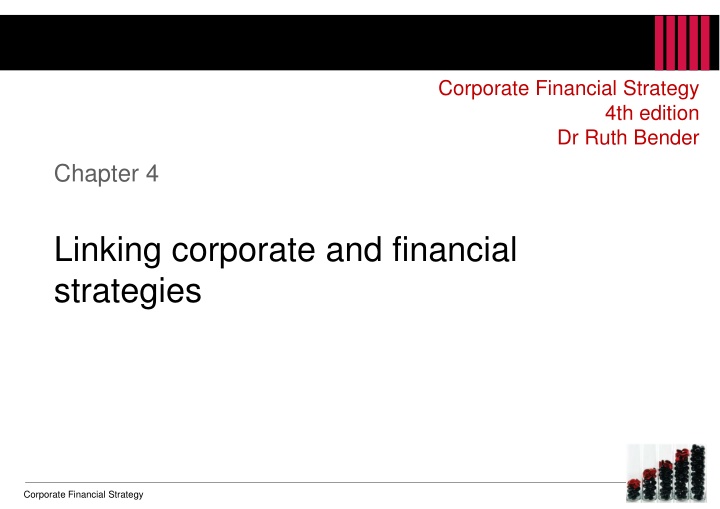
Corporate Financial Strategies for Value Maximization
Explore the key elements of corporate financial strategy, including distinguishing business risk from financial risk, assessing risk levels, drivers of value, and implications for public vs. private companies.
Download Presentation

Please find below an Image/Link to download the presentation.
The content on the website is provided AS IS for your information and personal use only. It may not be sold, licensed, or shared on other websites without obtaining consent from the author. If you encounter any issues during the download, it is possible that the publisher has removed the file from their server.
You are allowed to download the files provided on this website for personal or commercial use, subject to the condition that they are used lawfully. All files are the property of their respective owners.
The content on the website is provided AS IS for your information and personal use only. It may not be sold, licensed, or shared on other websites without obtaining consent from the author.
E N D
Presentation Transcript
Corporate Financial Strategy 4th edition Dr Ruth Bender Chapter 4 Linking corporate and financial strategies Corporate Financial Strategy
Linking corporate and financial strategies: contents Learning objectives Business risks reflect the volatility of results Elements of business risk Porter s five forces Environmental analysis PESTLE Resource-based theory Developing strategies to enhance shareholder value Decisions in financial strategy Risk from different perspectives Balancing business and financial risk Balancing business and financial risk in private companies Pecking order 2 Corporate Financial Strategy
Learning objectives 1. Distinguish business risk and financial risk, and explain why there should be an inverse relationship between them. 2. Explain the different elements of financial strategy. 3. Assess how risky a particular business is, with a view to understanding how it should be financed. 4. Understand the seven drivers of value, and how they can be related to business strategy in order to increase value. 5. Discuss how the elements of financial strategy might apply differently to public and privately owned companies. 3 Corporate Financial Strategy
Business risk reflects the variability of results Price Volume Sales Costs = Profits Products Markets Fixed Variable Committed 4 Corporate Financial Strategy
Elements of business risk Demand volatility Input cost volatility Growth drivers Selling price volatility Expense volatility Industry analysis Working capital needs Corporate governance Currency exposures 5 Corporate Financial Strategy
Porters five forces New entrants Customers Rivalry Suppliers Substitutes 6 Corporate Financial Strategy Porter, M. (2004). Competitive Strategy,
Environmental analysis PESTLE Political Economic Social Technological Legal Environmental 7 Corporate Financial Strategy
Resource-based theory V R I N aluable are mperfectly imitable on-substitutable 8 Corporate Financial Strategy
Developing strategies to enhance shareholder value Market views of the company Management ability Corporate governance External forces SHAREHOLDER VALUE VALUEDRIVERS STRATEGY Resources KPIs Targets 9 Corporate Financial Strategy
Decisions in financial strategy How large should the asset base be? How much of the finance should be debt? How much should be paid in dividends? Should we issue new shares? 10 Corporate Financial Strategy
Risk from different perspectives Debt Interest must be paid Repayments must be made Lender might have the right to repossess assets Equity Can choose whether to pay dividends No repayment obligation Features for Issuer (the Company) A high-risk instrument A low-risk instrument Interest is contractual Repayment is contractual The lender might obtain security Dividends are at the discretion of the company No requirement to repay capital Features for Investor A low-risk instrument A high-risk instrument 11 Corporate Financial Strategy
Balancing business risk and financial risk High Business risk Low High Low Financial risk 12 Corporate Financial Strategy
Balancing business risk and financial risk in private companies High Business risk ? Low High Low Financial risk 13 Corporate Financial Strategy
Pecking order 1. Internal resources 2. Borrow 3. Issue equity 14 Corporate Financial Strategy
















